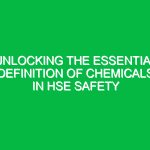Introduction
In the realm of Health, Safety, and Environment (HSE), understanding the fundamental difference between hazard and risk is paramount. These two terms are frequently used interchangeably, yet they represent distinct concepts that play crucial roles in Workplace Safety and environmental protection. This article aims to clarify these terms, delve into their implications, and explore how recognizing their differences can enhance Safety practices and promote a culture of Prevention within organizations. By unpacking the difference between hazard and risk, we can better equip ourselves to foster a safer working environment and mitigate potential dangers effectively.
The Concepts of Hazard and Risk
To grasp the difference between hazard and risk, we must first define each term clearly. A **hazard** refers to anything that has the potential to cause harm. This could be a substance, an activity, a condition, or even a process. For example, chemicals used in manufacturing, machinery in a factory, or even the height of a scaffolding can all be considered Hazards if they pose a threat to individuals or the environment.
On the other hand, **risk** is the likelihood that a hazard will actually cause harm, combined with the severity of that harm. In simpler terms, risk assesses the probability of an adverse event occurring and the extent of its consequences. For instance, while a chemical spill (the hazard) could potentially harm workers and the environment, the risk would evaluate how likely such a spill is to occur and what the outcomes might be if it does.
Hazard vs. Risk: Key Differences
Understanding the key differences between hazard and risk is crucial for effective Safety management. Here are some essential points to consider:
- Nature: Hazards are inherent characteristics of substances or activities, whereas risk is a measure of the potential for harm.
- Assessment: Hazards can often be identified through inspections and evaluations, while risk requires a more detailed analysis, considering both the likelihood of events and their potential impacts.
- Management: Hazard management focuses on eliminating or controlling Hazards, while risk management involves assessing and mitigating risks associated with those hazards.
Real-World Examples Illustrating the Difference
Consider a construction site. The height of scaffolding represents a **hazard**—it is a condition that could lead to falls. However, if the scaffolding is properly erected, maintained, and used by trained personnel, the **risk** of someone falling may be low. Conversely, if the scaffolding is poorly constructed or if workers are not trained, the risk of injury increases significantly.
Another example can be drawn from the chemical industry. A toxic substance stored in a facility is a **hazard**. However, if the facility has robust safety protocols in place, such as proper ventilation, personal protective equipment (PPE), and emergency response plans, the **risk** of exposure or accidents is minimized. Understanding these distinctions helps organizations develop effective safety protocols tailored to their specific environments.
The Importance of Recognizing the Difference in HSE
The significance of understanding the difference between hazard and risk cannot be overstated, particularly in the context of HSE. Here are several reasons why this distinction is critical:
1. Enhanced Safety Practices
By identifying hazards and assessing associated risks, organizations can prioritize Safety Measures. For instance, if an organization recognizes that a specific chemical poses a significant hazard but the risk is low due to stringent controls, resources can be allocated effectively to address more pressing risks.
2. Legal Compliance
Many Regulations and Standards require organizations to identify hazards and assess risks. Failure to do so can result in legal penalties. Understanding the difference aids organizations in developing compliance strategies that not only meet regulatory requirements but also foster a culture of safety.
3. Resource Allocation
In the world of HSE, resources are often limited. By understanding which hazards pose higher risks, organizations can allocate their resources—whether it be time, money, or personnel—more effectively. This targeted approach ensures that the most significant threats are managed first, leading to better overall safety outcomes.
Risk Assessment Procedures
To effectively manage hazards and risks, organizations must implement systematic risk assessment procedures. Here’s a step-by-step approach to conducting a thorough risk assessment:
1. Hazard Identification
The first step is to identify all potential hazards within the workplace. This can be achieved through various methods, including safety audits, employee feedback, and reviewing incident reports. For example, in a manufacturing plant, hazards might include machinery, chemicals, and ergonomic risks.
2. Risk Analysis
Once hazards are identified, the next step involves analyzing the risks associated with each hazard. This includes evaluating the likelihood of an incident occurring and the potential severity of its consequences. Tools such as risk matrices can aid in this analysis, allowing organizations to categorize risks based on their level of severity.
3. Risk Evaluation
After analyzing risks, organizations must evaluate whether the identified risks are acceptable or if further action is required. This involves comparing the evaluated risk against the established risk criteria. If a risk is deemed unacceptable, it necessitates intervention.
4. Risk Control Measures
If risks are identified as unacceptable, organizations must implement Control Measures. This may involve engineering controls, administrative policies, and PPE. For example, if the risk of chemical exposure is high, implementing proper ventilation and requiring PPE would be essential.
5. Monitoring and Review
The final step in a risk assessment is continuous monitoring and reviewing of the processes in place. Regular audits and employee feedback can help organizations adapt their Safety Measures and ensure ongoing protection.
Regulations and Standards Impacting Hazard and Risk Management
Understanding the difference between hazard and risk is also essential in the context of regulatory compliance. Several regulations govern Workplace Safety and environmental protection. Familiarizing oneself with these regulations can provide insight into Best Practices and legal obligations.
- Occupational Safety and Health Administration (OSHA): osha provides guidelines for identifying and mitigating hazards in the workplace. Their regulations emphasize the importance of recognizing both hazards and risks.
- Environmental Protection Agency (EPA): The EPA regulates environmental hazards and requires organizations to assess risks associated with environmental impacts.
- ISO 45001: This international standard outlines requirements for Occupational Health and safety management systems, emphasizing the need for hazard identification and risk assessment.
Organizations that adhere to these regulations not only ensure compliance but also demonstrate a commitment to maintaining a safe and healthy environment for their employees and the community.
Conclusion
In conclusion, unlocking the critical difference between hazard and risk is essential for effective health, safety, and environmental management. By understanding that a hazard is a potential source of harm and risk is the likelihood and impact of that harm, organizations can develop comprehensive Safety Strategies that prioritize prevention and compliance. The implications of this understanding extend beyond mere regulatory compliance; they foster a culture of safety that can save lives and protect the environment.
As we move forward in our HSE endeavors, let us continue to educate ourselves and our teams on the significance of these concepts. By doing so, we not only enhance our safety practices but also contribute to a sustainable future where health, safety, and environmental considerations are at the forefront of all operations.


